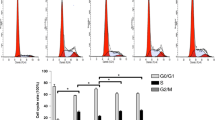Summary
In order to evaluate the effectiveness of everolimus vs. rapamycin in the treatment of diabetic nephropathy, 8-week old diabetic (db/db) mice received everolimus (2 mg/kg every day) or rapamycin (2 mg/kg every day) for 4 weeks or 12 weeks respectively. Blood and 24-h urine samples were collected for biochemical tests. One kidney from each mouse was homogenized for protein analysis and the other was removed for histological analysis. The expression levels of transforming growth factor-β1 (TGF-β1)and phospho-p70s6k were detected by using ELISA and Western blot, respectively in the renal tissue as well as in mesengial cell culture samples. Everolimus was significantly more effective than rapamycin in improving indexes of renal function and glomerular hypertrophy, and in decreasing accumulation and expansion of the extracellular matrix. However, everolimus inhibited TGF-β1 secretion and p70s6k phosphorylation induced by high glucose in vitro less efficiently than rapamycin at the same dose. Everolimus was more effective than rapamycin in preventing diabetic nephropathy in vivo, which may be contributed to the fact that everolimus has better bioavailability and a higher oral absorption rate.
Similar content being viewed by others
References
Remuzzi G, Schieppati A, Ruggenenti P. Clinical practice. Nephropathy in patients with type 2 diabetes. New Eng J Med, 2002,346(15):1145–1151
Cooper ME. Pathogenesis, prevention, and treatment of diabetic nephropathy. Lancet, 1998,352(9123):213–219
Awad AS, Huang L, Ye H, et al. Adenosine A2A receptor activation attenuates inflammation and injury in diabetic nephropathy. Am J Physiol, 2006,290(4):F828–837
Gross JL, de Azevedo MJ, Silveiro SP, et al. Diabetic nephropathy: diagnosis, prevention, and treatment. Diabetes Care, 2005,28(1):164–176
KDOQI Clinical Practice Guidelines and Clinical Practice Recommendations for Diabetes and Chronic Kidney Disease. Am J Kidney Dis, 2007,49(Suppl 2):S12–S154
Molitch ME, DeFronzo RA, Franz MJ, et al. Nephropathy in diabetes. Diabetes Care, 2004,27(Suppl 1): S79–S83
Lloberas N, Cruzado JM, Franquesa M, et al. Mammalian target of rapamycin pathway blockade slows progression of diabetic kidney disease in rats. J Am Soc Nephrol, 2006,17(5):1395–1404
Sakaguchi M, Isono M, Isshiki K, et al. Inhibition of mTOR signaling with rapamycin attenuates renal hypertrophy in the early diabetic mice. Biochem Biophys Res Commun, 2006,340(1):296–301
Sataranatarajan K, Mariappan MM, Lee MJ, et al. Regulation of elongation phase of mRNA translation in diabetic nephropathy: amelioration by rapamycin. Am J Pathol, 2007,171(6):1733–1742
Mori H, Inoki K, Masutani K, et al. The mTOR pathway is highly activated in diabetic nephropathy and rapamycin has a strong therapeutic potential. Biochem Biophys Res Commun, 2009,10384(4):471–475
Lee CH, Inoki K, Guan KL. mTOR pathway as a target in tissue hypertrophy. Annu Rev Pharmacol Toxicol, 2007,47:443–467
Chen JK, Chen J, Neilson EG, et al. Role of mammalian target of rapamycin signaling in compensatory renal hypertrophy. J Am Soc Nephrol, 2005,16(5):1384–1391
Fraenkel M, Ketzinel-Gilad M, Ariav Y, et al. mTOR inhibition by rapamycin prevents beta-cell adaptation to hyperglycemia and exacerbates the metabolic state in type 2 diabetes. Diabetes, 2008,57(4):945–957
Chung J, Kuo CJ, Crabtree GR, et al. Rapamycin-FKBP specifically blocks growth-dependent activation of and signaling by the 70 kd S6 protein kinases. Cell, 1992,69(7):1227–1236
Cohen MP, Sharma K, Guo J, et al. The renal TGF-beta system in the db/db mouse model of diabetic nephropathy. Exp Nephrol, 1998,6(3):226–233
Fingar DC, Blenis J. Target of rapamycin (TOR): an integrator of nutrient and growth factor signals and coordinator of cell growth and cell cycle progression. Oncogene, 2004,23(18):3151–3171
Yang Y, Wang J, Qin L, et al. Rapamycin prevents early steps of the development of diabetic nephropathy in rats. Am J Nephrol, 2007,27(5):495–502
Wolf G. Molecular mechanisms of diabetic renal hypertrophy: role of p27Kip1. Kidney Int, 1999,56(4):1262–1265
Shankland SJ, Scholey JW, Ly H, et al. Expression of transforming growth factor-beta 1 during diabetic renal hypertrophy. Kidney Int, 1994,46(2):430–442
Ziyadeh FN, Sharma K, Ericksen M, et al. Stimulation of collagen gene expression and protein synthesis in murine mesangial cells by high glucose is mediated by autocrine activation of transforming growth factor-beta. J Clin Invest, 1994,93(2):536–542
Benigni A, Zoja C, Corna D, et al. Add-on anti-TGF-beta antibody to ACE inhibitor arrests progressive diabetic nephropathy in the rat. J Am Soc Nephrol, 2003,14(7): 1816–1824
Schuler W, Sedrani R, Cottens S, et al. SDZ RAD, a new rapamycin derivative: pharmacological properties in vitro and in vivo. Transplantation, 1997,64(1):36–42
Crowe A, Bruelisauer A, Duerr L, et al. Absorption and intestinal metabolism of SDZ-RAD and rapamycin in rats. Drug Metab Dispos, 1999,27(5):627–632
Kovarik JM, Hartmann S, Figueiredo J, et al. Effect of rifampin on apparent clearance of everolimus. Ann Pharmacother, 2002,36(6):981–985
Kirchner GI, Meier-Wiedenbach I, Manns MP. Clinical pharmacokinetics of everolimus. Clin pharmacokinet, 2004,43(2):83–95
Author information
Authors and Affiliations
Corresponding author
Rights and permissions
About this article
Cite this article
Cheng, L., Chen, J. & Mao, X. Everolimus vs. rapamycin for treating diabetic nephropathy in diabetic mouse model. J. Huazhong Univ. Sci. Technol. [Med. Sci.] 31, 457–462 (2011). https://doi.org/10.1007/s11596-011-0473-5
Received:
Published:
Issue Date:
DOI: https://doi.org/10.1007/s11596-011-0473-5




